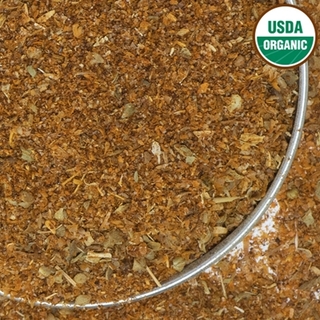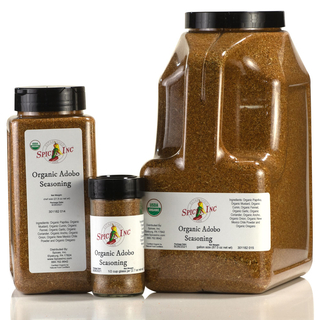Organic Adobo Seasoning




Organic Adobo Seasoning
Rich in flavor and mild in heat, our Organic Adobo Seasoning delivers the classic flavors of Latin America in an easy-to-use blend that’s made from 100% organic ingredients and is even salt-free. It is also called adobo spice, salt-free adobo, and salt-free adobo seasoning.
What is Organic Adobo Seasoning?
One must clarify what they mean when talking about adobo, which is one of several different things in today’s culinary world. Adobo can be a spicy and tart tomato-and-pepper-based sauce that’s splashed with vinegar and is often made pungent with the addition of smoky chipotle peppers. It can be a versatile seasoning blend that tends toward the mild side while reflecting regional differences and preferences in Latin American cooking. Or, it can refer to a traditional Filipino stew that was so named by Spanish colonizers when they saw this dish and thought it looked like their own, vinegary adobo sauce; the original name of the Filipino dish has been lost to time.
Our Organic Adobo Seasoning is a salt-free Mexican-style seasoning blend, flavored with fruity chiles that deliver hints of chocolate and gentle spice. It’s brimming with pungent aromatics, and adds an earthy, hearty flavor without overtly spicy heat.
The History of Adobo Seasoning
Adobo Seasoning has enjoyed a long and complex history. The name is derived from the Spanish word adobar, “to marinate”, as it originally described the method by which Spanish and Portuguese sailors preserved meat pre-refrigeration—in vinegar, with spices. This liquid used to soak meat is called adobo mojado, which literally translates to “wet marinade”. In Portuguese it’s called carne de vinha d'alhos, which means “meat in wine and garlic”, and is also the basis for the spicy Indian dish vindaloo.
Spanish conquistadors brought Adobo to the Americas during the Age of Exploration, beginning in the Caribbean with Christopher Columbus’s first landing in 1492. The dry seasoning blend—adobo seco—was originally created to mimic the flavors of the Spanish marinade, only without the liquid. Thanks to its Spanish background, it was originally made with a significant amount of Paprika, but as it was carried from the islands of the West Indies and into central America, it began to change. Adobo began to reflect the preferred seasonings and available flavorings of the regions in which it was mixed. Paprika was nixed in Mexico in favor of Ancho Chiles, and the earthy depth of Cumin joined the original lineup of garlic, onion, and pepper for a well-balanced and incredibly versatile blend.
What Does Organic Adobo Seasoning Taste Like?
The lilting aroma of fruity coriander is the first thing to greet you as you open a bottle of Organic Adobo Seasoning, with cumin and chile peppers mingling behind it. The rich, bitter chocolate of ancho chiles and the welcoming warmth of paprika launch the flavor of this seasoning, shored up by the aromatic pungency of garlic and onions and the profoundly earthy depth of cumin. Fennel and coriander add a light lift in the middle, while oregano adds a peppery depth. This blend finishes with a gentle, lingering heat that comes from the pop of bold mustard and the fruity spice of guajillo chiles.
What Is the Difference Between Adobo and Sazon Seasoning?
Both Adobo Seasoning and Sazon Seasoning are versatile blends that are much beloved throughout the kitchens of Latin America, and share some similarities. They are both mild, and deliver a tremendous amount of flavor to whatever they’re used in. They both rely on aromatics like garlic and onions, and get a bit of depth from cumin.
Sazon, however, is primarily used in Puerto Rican kitchens, and incorporates annatto seeds, not chile peppers, into the mix. The seeds give Sazon a profoundly earthy flavor and no heat at all. Sazon ingredients are also somewhat less flexible; Sazon will always taste like Sazon, wherever you get it. Adobo Seasoning is more reflective of the area in which it’s created. Ours has a Mexican flair thanks to the inclusion of chile peppers, but chefs in other regions may make it more earthy with the addition of turmeric, or smoky thanks to some chipotle peppers.
How to Use Organic Adobo Seasoning
One of the benefits of Organic Adobo Seasoning is its exceptional versatility. First up: Round out your Adobo experience by making a spicy Chipotle Adobo Sauce, and—trust us on this—stir this sauce into mashed sweet potatoes for a sweet-and-spicy side for London broil. Add this to any recipe for burritos or tacos. Make a Mexican-style pot of hearty, smoky Borracho Beans or use this to season a Taco-Stuffed Zucchini for a lighter take on Mexican-inspired food. Try it on pork kebabs, or substitute Organic Adobo Seasoning into a Kebab Salad Bowl. This would be wonderful sautéed with fresh corn kernels and poblano peppers for an end-of-summer side dish. The flavor might be too assertive for some of the more delicate vegetables, but we recommend tossing it on broccoli to grill, or add to flavor-forward leafy greens like collards or mustard.
The flavors in our Organic Adobo Seasoning are fairly assertive. We recommend using two teaspoons of Organic Adobo Seasoning per pound of meat, and add more seasoning as you go, if desired.
What Can I Use in Place of Adobo Seasoning?
Many national brands of Adobo Seasoning are packed with salt and other flavor enhancers, so we do recommend giving our salt-free, Organic Adobo Seasoning a try before looking for a substitute. If you’re in a pinch, though, and can’t get your hands on Adobo Seasoning, we suggest you try a relatively mild, Mexican-inspired blend. Our Manzanillo Seasoning has a bit more heat—but not too much!—and is packed with classic Mexican flavors. It also comes in an organic option. Al Pastor Taco Seasoning has similarly earthy flavors as Adobo, though it’s not as herbaceous. Enchilada Seasoning has a touch of sugar to sweeten it up and a bit of salt, but it’s got loads of gentle paprika and fragrant herbs like coriander and oregano to really build the flavor.
| Ingredients | Organic paprika, organic mustard, organic cumin, organic fennel, organic garlic, organic onion, organic coriander, organic ancho, organic pasilla, and organic oregano. |
| Also Called | Adobo spice, salt-free adobo, and salt-free adobo seasoning |
| Recommended Uses | Use in, marinades, over strongly-flavored meat, with beans |
| Flavor Profile | Earthy and fragrant, with a bitter edge and mild, lingering spice |
| Cuisine | Mexican, Caribbean, Spanish |
| How To Store | Airtight container in a cool, dark place |
| Shelf Life | 6 months-1 Year |
| Country of Origin | USA |
| Dietary Preferences | Gluten Free, Organic, Non-GMO |
Hungry for more information?
What Are GMOs?
Flavorful Latin Food: More than Just Tacos and Jamaican Jerk Seasoning
Most Popular Spices by Cuisine
The Ultimate Guide to Mexican Spices
Nutrition Facts
Serving Size1 tsp
Amount Per Serving
Calories11
% Daily Value*
Total Fat0g1%
Saturated Fat0g0%
Trans Fat0g
Polyunsaturated Fat0g
Monounsaturated Fat0g
Cholesterol0mg0%
Sodium2.0mg0%
Total Carbohydrate1.8g1%
Dietary Fiber0.8g3%
Total Sugars0.1g
Added Sugars0g0%
Sugar Alcohol0.0g
Protein0.5g1%
Vitamin D0mcg0%
Calcium17mg1%
Iron1mg3%
Potassium52mg1%
*The % Daily Value (DV) tells you how much a nutrient in a serving of food contributes to a daily diet. 2,000 calories a day is used for general nutrition advice. These values were calculated and therefore are approximate. For more accuracy, testing is advised.
